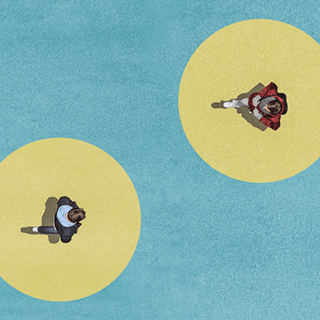What It’s Like to Live With explores the stories of people who see and experience every day a little differently.
When I was six, while playing Dark Room with my brother’s friends, I hid in the storage drawer under the bed. For a while, I was completely fine. I think everyone forgot I was playing with them after a point and stopped looking for me. I couldn’t push the drawer to get myself out and the panic set in. I began to shout and eventually someone heard me and got me out. I must have been stuck for a solid 10–15 minutes, if I remember correctly.
Since that day, I began fearing dark, small places. I stopped playing in the parking lot of my building and, in the process, lost many friends. Nobody in my family took it too seriously, thinking my fear was temporary and only related to the small incident. We all thought it would pass, but it didn’t. Eventually, I was afraid of being in lifts and I would insist on keeping the doors and windows of my house open all the time. Sometimes, I wouldn’t even lock the bathroom door. When I had to use public washrooms, I would ask my mother or friends to accompany me so they could hold the door for me. This went on for a while, until one day I got trapped in an elevator.
I was 21 and alone. Due to a technical glitch, the elevator stopped working. Although it wasn’t a closed elevator, I still experienced difficulty breathing and ended up with a terrible headache. That’s when my parents decided to take me to a psychotherapist, who said I suffered from anxiety and claustrophobia. It was a sigh of relief because she had confirmed there was a problem and we now had a name for it. We knew the reason behind the mild panic attacks, breathing problems, headaches, and dizziness.
Related on The Swaddle:
What It’s Like to Live With: Chronic Fatigue Syndrome
Over the years, I can say the problem has remained the same, if not worsened. I’m 36 now and still don’t take elevators. If I absolutely have to, I insist on having company. Traveling on airplanes is difficult and I request to be let out the first no matter where I’m sitting, and I can’t stay in hotel rooms with sealed windows. I even prefer rickshaws over cabs because I’m worried I’ll get stuck because of the auto-locking system.
I shifted to Mumbai from Kolkata three years ago and house hunting was a pain — I was used to big, open houses in my home city. Mumbai homes are very tiny and often don’t have balconies. In the first few homes we saw, there was hardly any light or ventilation, and we had to refuse them all even though they were situated very close to our offices. I finally had to choose one on the first floor, despite my husband wanting one on a higher floor, to avoid taking the lift.
Although my husband’s help and support helps me feel better, the lockdown has exacerbated my issues. Our building is not allowing us to go to the terrace and we don’t have a balcony. Someone in the next building tested positive for Covid19, so the management has requested us not to get out unless absolutely necessary.
A month into the lockdown, I haven’t stepped out even once and staying in has resulted in many mild panic attacks, which areincreasingly getting worse. Our kitchen has a very tiny window, which means that I can’t cook for too long, so my husband does it. I sit by the window all day to work, sometimes not even switching on the air-conditioner despite the heat because I need the room to be open and airy all the time.
Even though I do telephone and video sessions with my therapist when it becomes too much, it’s quite difficult not knowing when this lockdown and confinement will come to an end. This fear of the unknown makes living with claustrophobia even more unpleasant.
This interview has been condensed and edited for clarity. As told to Anubhuti Matta.




